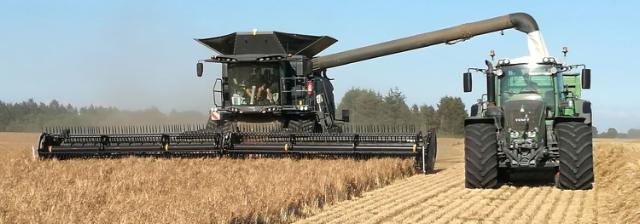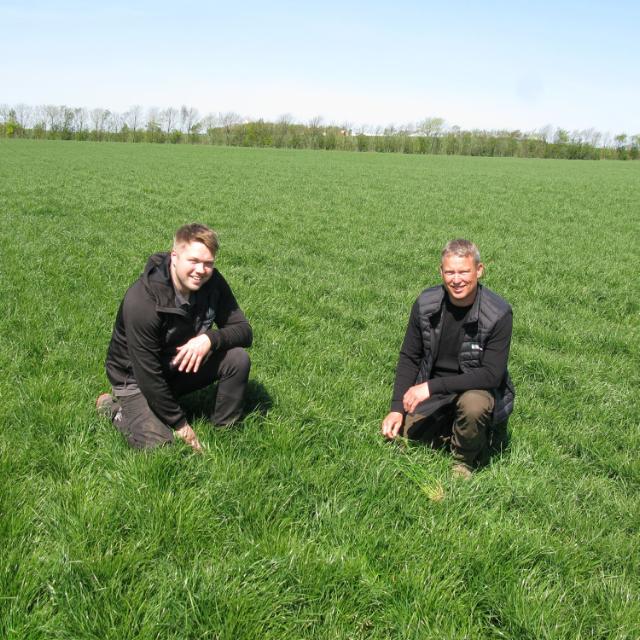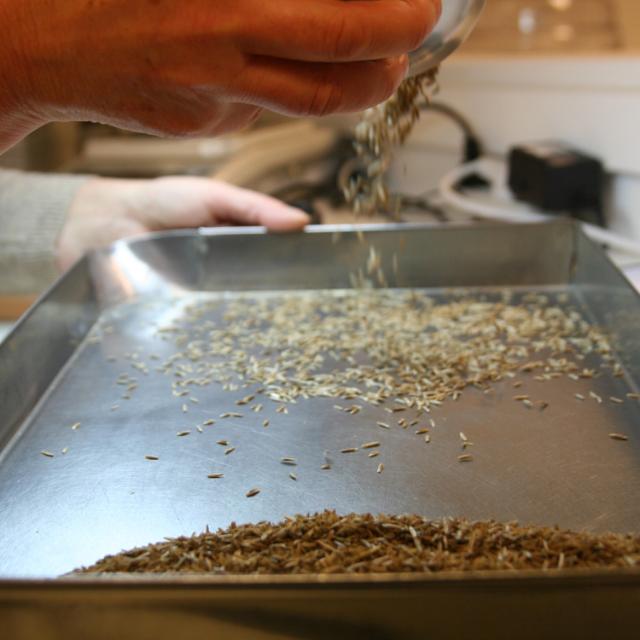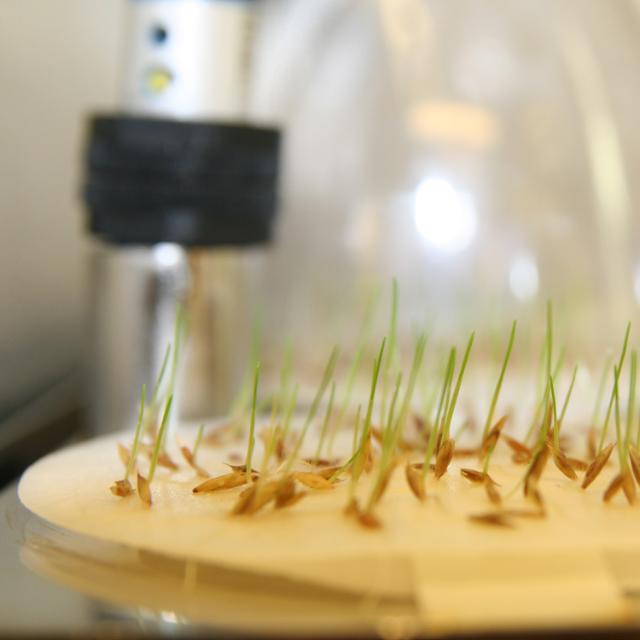
Seed certification and quality
International trade in seeds is quite rightly subject to a regime of certification. Supplying seed to national and international certification standards comes naturally to us because we export seed worldwide – and we've been producing to certification standards for years. Certification guarantees that the seed you buy from us is uniform, reliable, and of the quality you expect. Our seed certification programme involves field inspections, seed sampling, laboratory tests and pre and post-control cultivation. At every stage, we produce seeds you can trust.
You can't beat top-quality Danish seed
We produce most of our clover and grass seed in Denmark. A temperate climate and 7.300 km of coast line provide near-perfect conditions for seed production. Rain falls evenly throughout the growing season and the surrounding seas soften temperature variations. The conditions are ideal for a wide range of grass and clover species.
We also produce seed through contract production in other DLF Group companies: DLF (The Netherlands), DLF (Czech Republic), DLF Pickseed (USA), and DLF Pickseed (Canada). All grass seed produced in Denmark and The Netherlands is certified to EU standards.
Regular field inspections ensures the best growing conditions
To grow the best seed, we start with the best growing conditions:
- Clean fields with low weed content
- Well-established crops
- Optimised strategy for fertilisers, weed control, and plant-growth regulators
- Ideal harvest time followed by optimal conditioning and drying
Our field advisors work closely with our seed producers at every stage from contract signing to harvest and delivery. They visit each field three or four times a season, offering as much free advice and practical support as our producers need to grow seed that meets the needs of a demanding market.
By combining our expertise with the skills of experienced seed growers, we get a top-quality crop from fields optimised for seed production. We achieve the best harvest for our producers and the best quality for our customers.

Certified seed is reliable seed
To be certified, every grass-seed variety has to be registered. That means it has to be listed on one of the Danish, EU, or OECD plant-variety catalogues. To be sold within the EU, however, the variety must be on the Danish or EU catalogues.
No seed gets a listing on any plant-variety catalogue without first undergoing comprehensive technical analysis. It must meet standards for:
- Distinctness
- Uniformity
- Stability
- Agricultural value based on:
- Yield
- Resistance to harmful organisms
- Response to the environment
- Quality characteristics

Seed generations or categories
Certification standards depend on the generation or 'category' of a seed. In the beginning we select a small portion of the breeder material for reproduction. This material is not necessarily produced under official control. All subsequent generations have to be under the strict control of an official certification authority.
The requirements for first generations (prebasic and basic seed) are higher than for later generations of certified seeds (C1/C2). The later generations are the basis on which we produce pure, uniform certified seeds of high quality.
Maintaining uniformity
We keep a standard sample of every variety. The standard is a living example of how each variety should perform. Comparing samples of certified seeds to the standard is known as post control. At our Post Control Station we sow samples of certified seed next to the standard sample. By comparing the two samples throughout the growing season, we can verify that the certified samples perform exactly like the standard. It's a guarantee of uniformity
Field inspections
All fields used for seed breeding are inspected by official or authorised field inspectors. For these early generations of a variety, the inspectors apply the most demanding standards. They're checking:
- Identity and purity of variety
- Purity of species
- Presence of wild oats (Avena fatua)
- Proximity to cross-pollinating species
- Weeds
- Diseases

Sampling and analysis
Seed that passes the field-inspection tests is harvested and cleaned. An authorised seed sampler then seals and labels the seed lot, and takes samples for testing.
All seed testing takes place at ISTA accredited laboratories. They send their results direct to the regulating authorities. If the sample fails to meet EU standards, the seed lot cannot be certified. The labels are removed from the seed lot.
Authorisation of the seed testing laboratory
DLF has two ISTA-accredited laboratories in Denmark, and one in the Netherlands. All are authorised by the certification authorities to test samples for certification purposes. The laboratories fulfil the ISTA requirements:
- Satisfactory premises and equipment
- Approved management and quality-assurance system including follow-up on non-conformities and written procedures
- Appropriate qualifications and officially examined and authorised seed analysts
- Seed-testing methods according to the ISTA rules
- Laboratory performance checked by internal and external audits and proficiency tests
There's no room for error in seed testing. That's why 5% of our samples are retested by an official seed-testing laboratory. The authorisation is granted by the certifying authority.
Authorisation of seed samplers
At DLF, the seed samples are sampling under official supervision. The authorisation is granted by the certifying authorities, and we meet the requirements:
- Quality-assurance system, follow up on non-conformities and written procedures
- Practical and theoretical training, official examed and authorised samplers
- Sampling tools and methods which meet the ISTA-requirements
- Appointed person-in-charge of the sampling activity
- Sampling under official supervision with annual audit and check-sampling


Our three ISTA-accredited laboratories
DLF has three ISTA (International Seed Testing Association) accredited laboratories: two in Denmark and one in the Netherlands. ISTA accreditation means that our seed-testing laboratories can test in accordance with ISTA's International Rules for Seed Testing and issue ISTA Orange International Seed Lot Certificates.
ISTA accreditation
ISTA accreditation is not easily achieved – or maintained. To become accredited, our laboratory processes and technical competence had to be assessed and verified by independent audit teams. To maintain our accreditation, the auditors come back regularly to check that our standards and quality-assurance scheme continue to meet ISTA requirements. We're also obliged to take part in proficiency tests in species for which we hold accreditation.
To find out about the test methods and crop groups for which each DLF laboratory is accredited, click the links below.
ISTA calibration samples by DLF
A technique known as the uniform blowing procedure is used to separate light-weight material such as chaff and empty florets from heavier seeds. To find the optimum blowing point of the seed blowers, the laboratory needs calibration samples of Poa species and Dactylis glomerata.
To maintain worldwide consistency of analysis, the International Seed Testing Association (ISTA) provides samples for calibration of blowers. These calibration samples, which are produces by DLF, are distributed through the ISTA Secretariat.